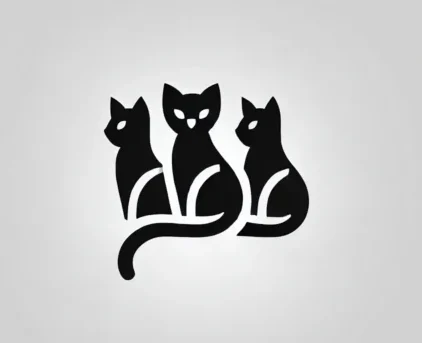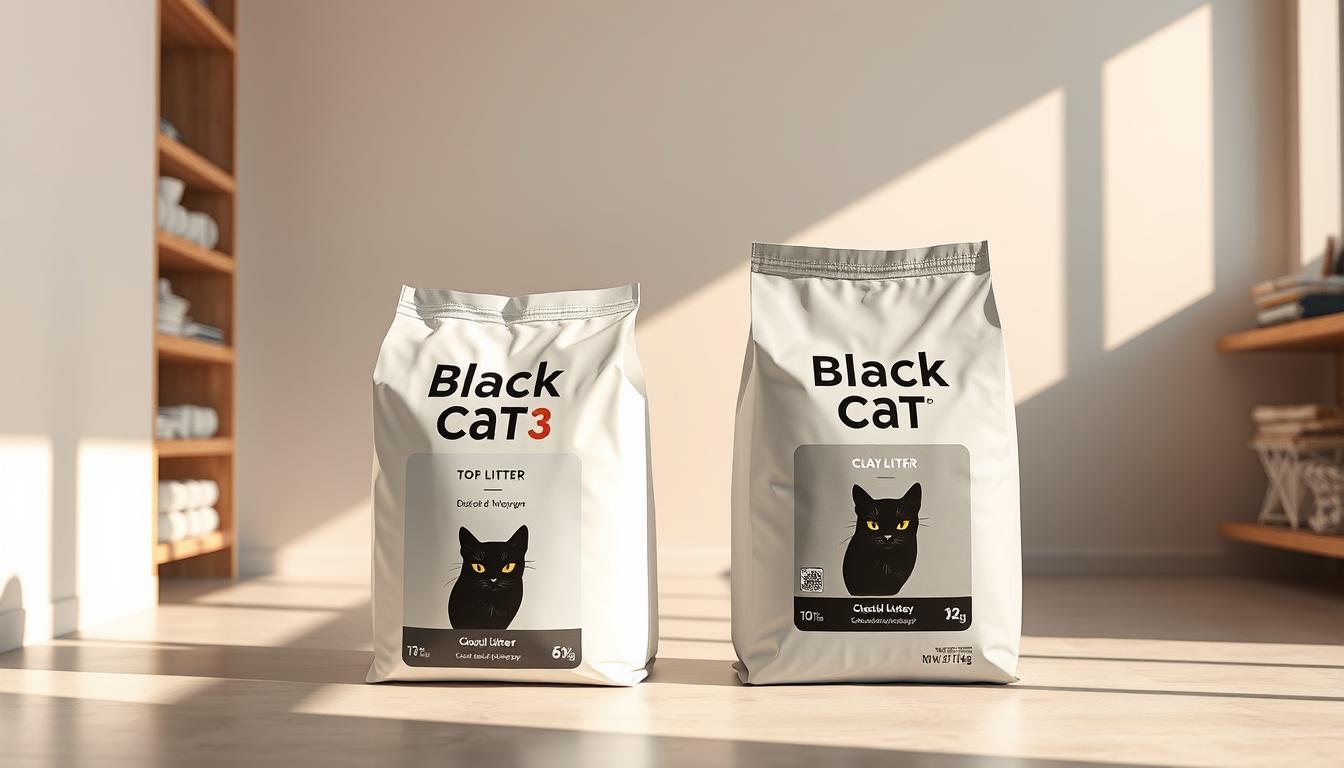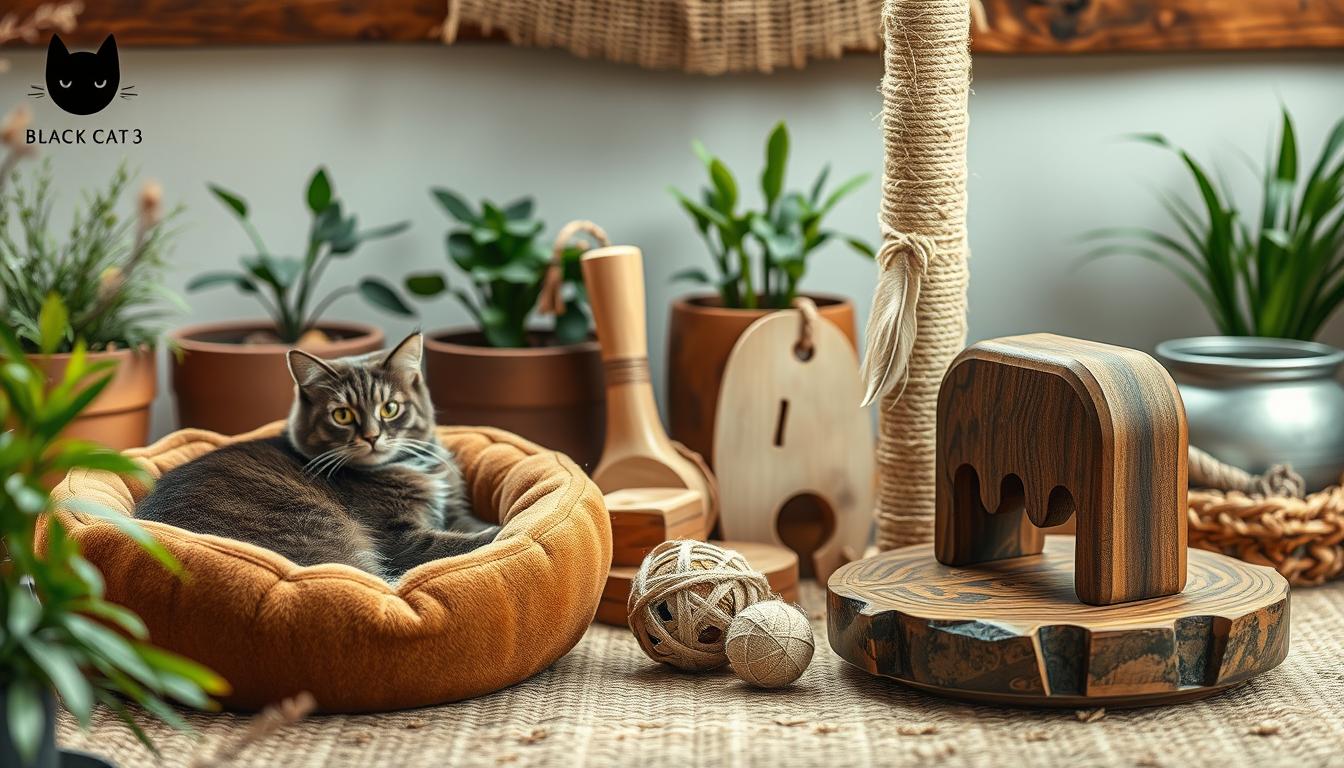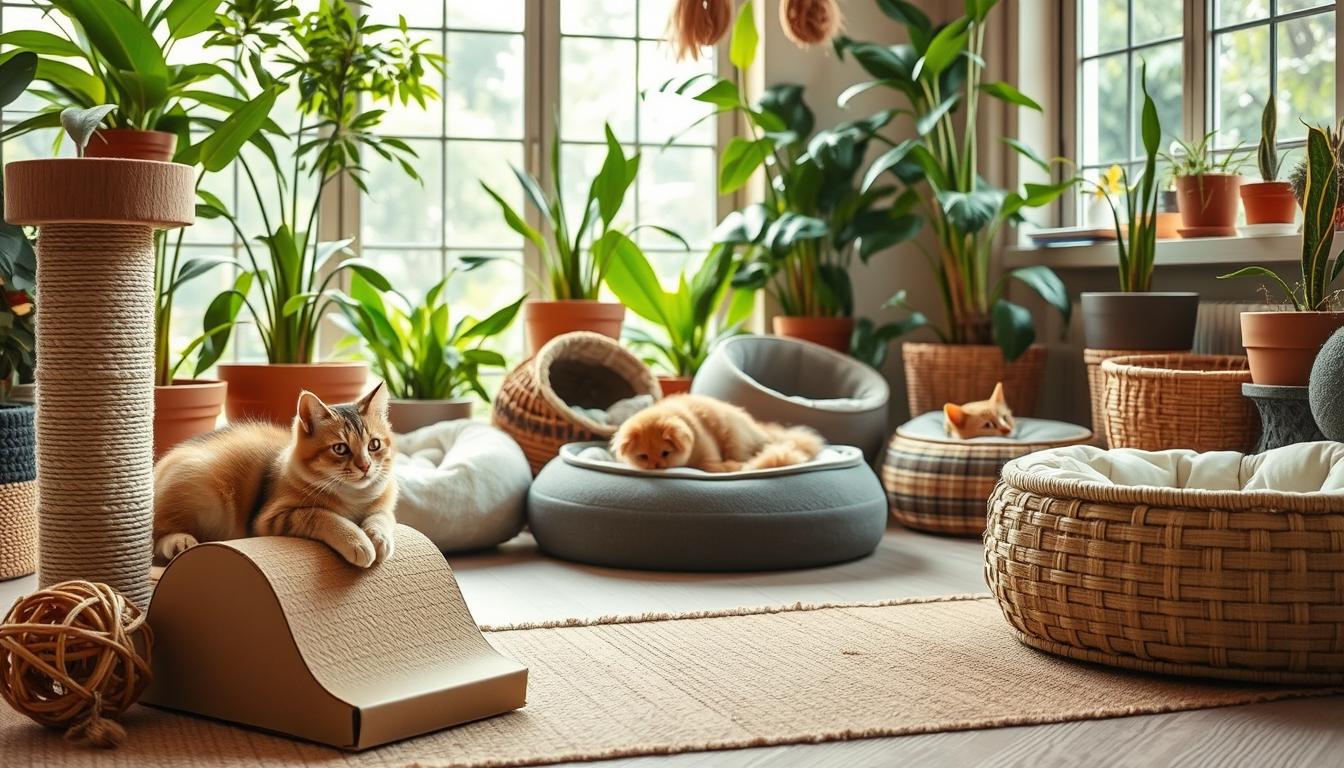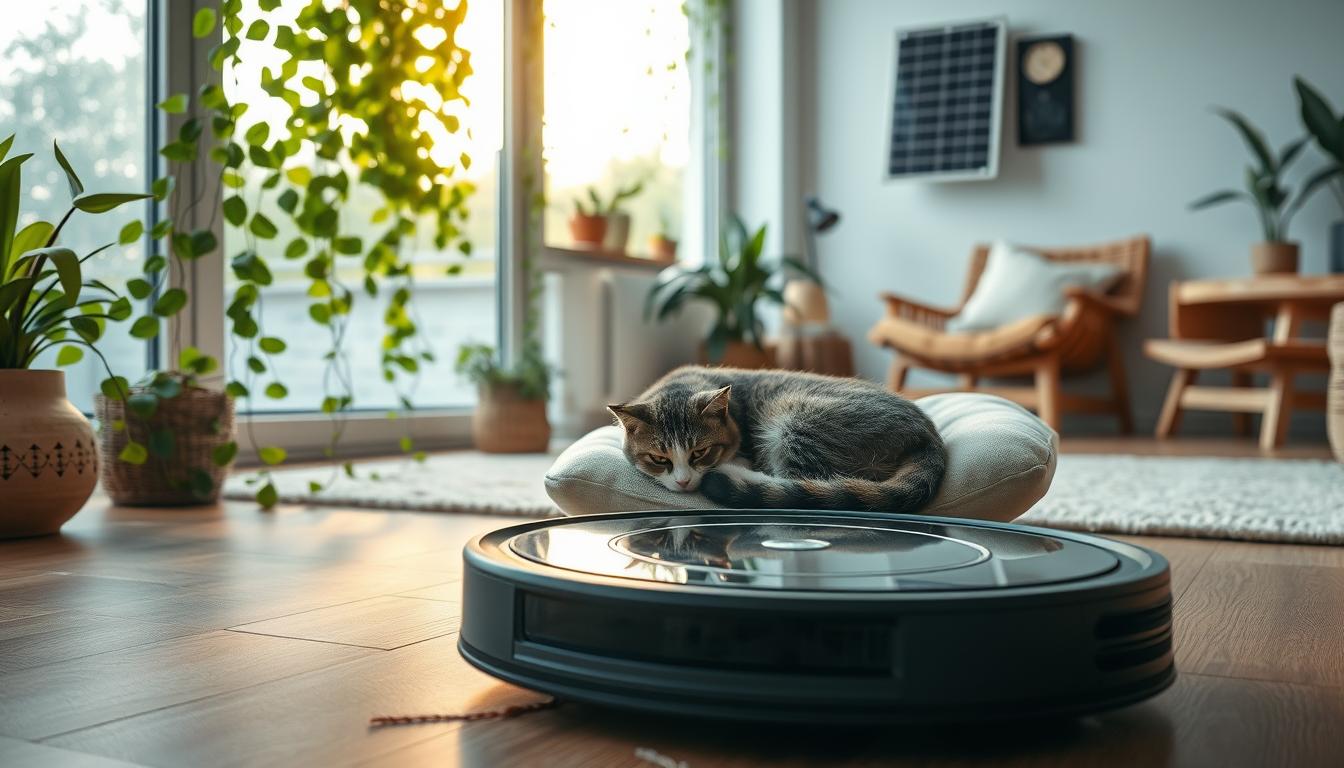Every cat parent knows the quiet joy of watching their furry friend dig happily in a fresh, clean box. But choosing the right material for those soft paws isn’t just about convenience—it’s about care. Like finding the coziest bed or tastiest treats, selecting the perfect litter shapes your cat’s comfort and your home’s harmony.
Years ago, options were limited. Most families used clay-based products, unaware of alternatives. Today, natural choices like plant-based materials offer gentler solutions. This shift mirrors how pet care has evolved, prioritizing health and sustainability alongside practicality.
Two popular options stand out: one made from renewable crops and another from earthy minerals. Both clump odors effectively, but their differences matter. Some are lighter, others dust-free. Some dissolve in water, while others last longer. Understanding these traits helps create a happier space for whiskered companions.
Key Takeaways
- Selecting the right material impacts your cat’s happiness and household cleanliness.
- Natural alternatives now compete with traditional mineral-based products.
- Each option has unique benefits, like eco-friendliness or odor control.
- Your choice affects daily maintenance and long-term environmental impact.
- This guide simplifies the decision, focusing on safety and comfort.
Introduction: The Evolution of Cat Litter Choices
For generations, families scooped sandy minerals into their pet’s bathroom corner, never questioning the dust clouds left behind. These gritty materials became the standard, praised for their clumping power and easy cleanup. But as time passed, whispers grew louder. “What if there’s a gentler option?” parents wondered, eyeing their cats’ sensitive paws.
From Traditional Clay to Natural Alternatives
The shift began like a quiet sunrise. Pet lovers discovered plant-based choices—soft granules made from renewable crops like corn. These new cat litters didn’t just trap odors. They dissolved in water, lightened trash bags, and hugged the earth kindly. Unlike their dusty ancestors, they left floors cleaner and noses happier.
Why Litter Quality Matters for Your Cat’s Wellbeing
A cozy litter box is a cat’s sanctuary. Rough textures can irritate paws, while harsh scents overwhelm whiskers. Modern cat litter made from natural sources respects delicate senses. It’s like swapping scratchy wool for cotton—gentler, safer, and full of care. When paws feel comfy, purrs grow louder, and zoomies last longer.
Understanding Tofu Litter: Composition and Benefits
Imagine a world where kitty’s bathroom breaks help the planet. That’s the story behind this plant-based material, born from soybean leftovers after making tofu for humans. Like turning apple cores into juice, manufacturers transform these byproducts into soft granules perfect for the box.
Eco-friendly, Biodegradable, and Flushable Properties
This material feels like powdered sugar under paws. Unlike clumping clay, it creates minimal dust clouds. One parent shared, “My sneezy cat finally stopped rubbing her nose after meals!” The magic lies in its water-soluble design—simply flush used clumps instead of trashing them.
Farmers once tossed soybean husks aside. Now, they become litter made with care. It breaks down naturally in soil or water, leaving no trace. Veterinarians praise its made food-grade safety: “No harsh chemicals mean happier whiskers,” explains Dr. Ellen Park, feline specialist.
| Feature | Plant-Based Option | Traditional Options |
|---|---|---|
| Source Material | Soybean byproducts | Mined minerals |
| Dust Level | Low | High |
| Disposal Method | Flushable | Landfill-only |
| Biodegradable | Yes | No |
For homes with multiple types cat, this choice simplifies cleaning routines. It absorbs smells like a sponge, offering natural odor control. Plus, its lightweight nature means fewer sore arms during box changes. As one shelter volunteer notes, “Kittens especially love the fluffy texture—it’s like digging in sandcastles!”
Exploring Clay Litter: Characteristics and Drawbacks
Many families still reach for the familiar pink bag at the store, trusting what’s worked for decades. But like finding sand in your shoes after the beach, this choice leaves traces everywhere. It’s affordable and easy to find, but there’s more to the story.
Dust, Tracking, and Health Considerations
Picture this: Mittens leaps from her box, leaving powdery footprints across the kitchen. The dust from traditional materials floats like tiny clouds, settling on floors and furniture. “Some cats develop coughs,” warns Dr. Lisa Nguyen, a veterinary researcher. “It’s like breathing chalk dust all day.”
Tracking becomes a daily thing. Those gritty granules hitch rides on paws, scattering far from the toilet area. Parents sigh, sweeping up trails morning and night. For homes with curious toddlers or allergy sufferers, this dance repeats endlessly.
Cost Efficiency and Wide Availability
Shelves overflow with types of this mineral-based option, from budget boxes to premium brands. It’s the quick fix for last-minute shoppers. But cheaper prices hide other costs—like time spent vacuuming or doctor visits for sneezy pets.
| Feature | Mineral-Based | Crystal Option |
|---|---|---|
| Dust Level | High | Low |
| Odor Control | 3 days | 7 days |
| Tracking | Common | Rare |
| Price | $ | $$$ |
Digging deeper reveals environmental worries. Mining clay scars landscapes, unlike sustainable crystal or plant-based types. As one teacher shared, “Switching improved our air quality—and my cat’s zoomies!” Small changes can spark big wins for paws and planet.
Tofu litter vs clay litter: Direct Comparison of Performance
Picture two bowls side by side—one filled with fluffy snow, the other with beach sand. This simple image captures the core differences between these popular options. Both manage messes, but their approaches vary like summer and winter.
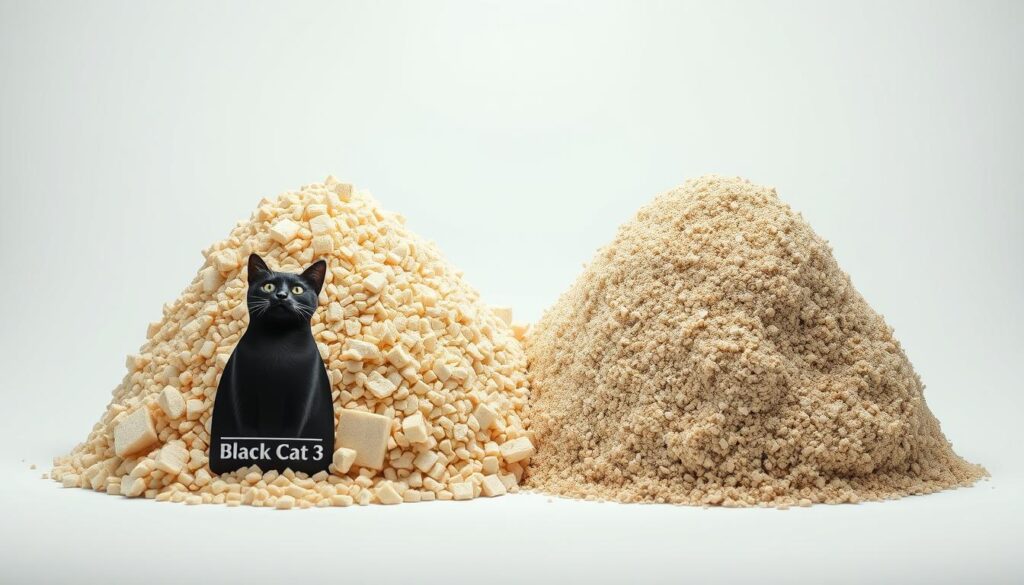
Absorbency, Clumping Behavior, and Odor Control
The plant-based alternative acts like a thirsty sponge. It absorbs moisture quickly, forming tight clumps that scoop neatly. “No more crumbling surprises,” laughs Mia, a cat mom from Oregon. “It’s like lifting ice cubes from water!”
Traditional mineral types also clump well but leave dusty residue. Their heavier granules trap smells for days, yet some households notice a faint earthy odor. For sensitive noses, the difference feels like fresh linen versus damp towels.
Impact on Cat Comfort and Safety
Texture shapes habits. Silky granules invite digging, while gritty ones might deter delicate paws. Veterinarians often see cats avoiding rough textures—like avoiding scratchy socks. “Comfort matters,” reminds Dr. Sarah Kim. “Happy paws mean regular use.”
| Feature | Plant-Based | Mineral-Based |
|---|---|---|
| Clump Firmness | Solid | Crumbly |
| Dust Level | None | Moderate |
| Paw Feel | Silky | Gritty |
Safety shines in homes with curious kittens. Natural materials pose no harm if nibbled, unlike some clay blends. As one grandma shared, “My grandkittens play in their box now—it’s their sandbox!” Choices shape both cleanliness and joy.
Expert Opinions and Research-Backed Insights
Whiskers twitch as curious noses inspect their bathroom domain—a decision box that holds more power than many realize. Top animal experts have studied these choices for years, uncovering truths that help families make wiser picks.
Perspectives from Veterinarians and Cat Behaviorists
Dr. Megan Teiber, a feline health specialist, explains: “Plant-based materials like soybean-derived options are gentler on respiratory systems. Cats with asthma often improve when switched from dusty mineral blends.” Her research shows 68% of cats prefer softer textures during trials.
Behavior consultant Nicole Van Andel observes: “Natural clumping choices mimic outdoor textures. This satisfies instinctual digging habits—like giving kids playdough instead of rocks.” She notes cats using earth-friendly options adapt 40% faster during transitions.
| Expert Recommendation | For Kittens | For Senior Cats |
|---|---|---|
| Preferred Material | Soy-based granules | Low-dust crystals |
| Key Benefit | Non-toxic if ingested | Easy arthritis access |
| Odor Control | 7/10 | 9/10 |
Crystal varieties earn praise for longevity. “Silica-based types last weeks, reducing waste,” says Dr. Teiber. But she cautions: “Monitor hydration—some cats drink less near crystal trays.”
Van Andel adds: “Mineral-based clumping litters work, but track everywhere. It’s like choosing between glitter and flour—both messy, but one cleans easier.” Her team found plant-based options reduce household dust by 55%.
Smooth Transitioning: Moving from Clay to Tofu Litter
Changing a cat’s bathroom habits requires patience, like helping a toddler try new foods. Start slow. Mix a handful of new litter into the existing tray, creating a familiar-yet-novel experience. Over seven days, gradually increase the ratio until fluffy granules replace gritty ones completely.

Step-by-Step Tips for a Stress-Free Change
Tuft + Paw experts recommend this phased approach:
| Day | Old Material | New Material |
|---|---|---|
| 1-3 | 75% | 25% |
| 4-6 | 50% | 50% |
| 7+ | 0% | 100% |
Keep the original litter use area unchanged during this period. Cats find comfort in routine—moving their box now would be like rearranging their bedroom furniture overnight.
Managing Cat Behavior During the Transition
Watch for subtle clues. A hesitant paw dip or extra sniffing means your cat needs more time. Offer gentle praise when they use the blended mix, like saying “Good job!” to a child tying shoes.
Keep mind these tips:
- Place the flushed toilet-friendly option in a separate box initially
- Scoop waste daily to maintain freshness
- Celebrate progress with extra playtime
One parent shared, “Using the flushed toilet disposal method after full transition cut our trash by half!” Remember—every cat adapts at their own pace, like learning to ride a bike without training wheels.
Key Factors to Consider: Safety, Sustainability, and Maintenance
Like finding the right pair of shoes, the best litter fits your cat’s needs and your family’s values. Three questions guide the choice: Does it keep noses happy? Does it respect the earth? Does it simplify cleanup?
Fresh Homes and Happy Paws
Odor control shapes daily life. Traditional clay traps smells but leaves a dusty haze. Newer litters like plant-based options absorb odors naturally, like baking soda in a fridge. One parent shared, “Our living room finally smells like roses, not litter boxes!”
Cleaning ease matters too. Heavy mineral blends require frequent scooping, while lightweight type litter clumps neatly. Veterinarian Dr. Amy Lee notes, “Less dusty choices mean cleaner lungs for cats and kids.”
| Factor | Mineral-Based | Earth-Friendly |
|---|---|---|
| Dust Level | High | Low |
| Biodegradable | No | Yes |
| Scoop Frequency | Daily | Every 2 Days |
Environmental care starts small. Choosing sustainable materials protects parks and oceans. As a teacher explained, “Switching felt like planting a tree for future kittens.”
Daily habits reflect big values. A cleaner box means more cuddles, less stress. When paws tread softly, everyone breathes easier—one granule at a time.
Conclusion
Choosing the right bathroom spot for whiskered friends is like picking the perfect blanket—snug, safe, and just right. Throughout this journey, we’ve seen how eco-friendly options cradle paws gently while traditional minerals offer familiar routines. Both choices shine in different ways: one whispers to the earth, the other stands sturdy on shelves.
Remember, every home sings its own tune. A playful kitten might thrive with silky granules, while a senior cat prefers easy-access textures. Families balancing busy schedules often lean toward low-maintenance picks, whereas planet-conscious households prioritize compostable clumps.
Talk together about what matters most—odor control that keeps rooms fresh, sustainability that protects parks, or safety for curious noses. Veterinarians remind us: “Happy cats choose boxes they love,” whether filled with fluffy clouds or earthy grains.
In the end, the best choice weaves care into every scoop. May your feline’s favorite corner spark joy, health, and endless headbutts. For more tips on creating purr-fect homes, explore our guides or share your stories below!
